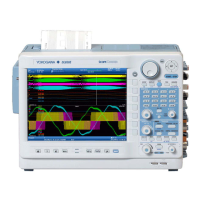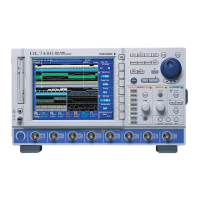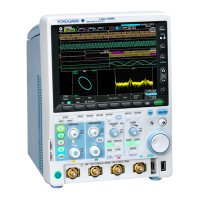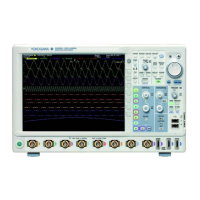2-24
IM DLM6054-01EN
2.7 Computed and Reference Waveforms
section 9.1 for the procedure
By specifying expressions for M1 to M4, you can display up to four computed waveforms.
section 9.8 for the procedure
You can display up to four reference waveforms by assigning them to M1 to M4.
If you set the measurement source to a channel from M1 to M4 when a reference waveform
is displayed, cursor measurements and automated measurements of waveform parameters
are performed relative to the reference waveform. You can also use the reference waveform in
calculations.
The following waveforms can be used as reference waveforms.
• W
aveforms that appear on the screen (CH1 to CH4 and M1 to M4)
• Saved waveforms
section 9.2 for the
procedure
In calculations for M1, addition, subtraction, and multiplication can be performed on two channels from
CH1 to CH4. In calculations for M2 to M4, addition, subtraction, and multiplication can be performed
on two channels from M1 and CH1 to CH4.
Addition and subtraction are useful for comparing a signal with a reference signal, checking signal
logic, and comparing phases. Multiplication can be used to produce a power waveform when the
DL6000/DLM6000 is receiving voltage and current signals.
section 9.4 for the procedure
You can integrate the selected waveform. The DL6000/DLM6000 takes the specified integration
start point as 0 and calculates the value for the entire area, counting up toward the newest data and
down toward the oldest data. In calculations for M1, you can integrate a channel from CH1 to CH4. In
calculations for M2 to M4, you can integrate M1 or a channel from CH1 to CH4.
Delay ( section 9.3 for the procedure
You can display a waveform with its phase shifted. To advance the phase, set a positive value. To
delay the phase, set a negative value.
section 9.3 for the procedure
You can filter out high frequency (low-pass filter) or low frequency (high-pass filter) noise.
You can select a first-order or a second-order filter. When a second-order filter is selected, there is no
phase delay.
section 9.3 for the procedure
You can use moving averaging to display a smooth waveform whose noise has been eliminated.
section 9.5 for the procedure
You can count the edges of the selected waveform. The DL6000/DLM6000 takes the specified
counting start point as 0 and counts all the edges in the entire area, counting up toward the newest
data and down toward the oldest data. In calculations for M1, you can count the edges of a channel
from CH1 to CH4. In calculations for M2 to M4, you can count the edges of M1 or a channel from CH1
to CH4.
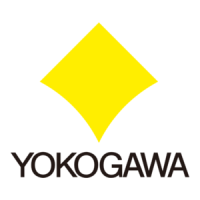
